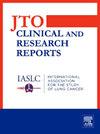新辅助同步放化疗治疗局部晚期高级别胸腺肿瘤的II期临床试验
IF 3.5
Q2 ONCOLOGY
引用次数: 0
摘要
局部晚期胸腺肿瘤的最佳治疗仍有争议。我们进行了一项临床试验(ChiCTR-TNC-10001204),以研究局部晚期胸腺肿瘤患者新辅助同步放化疗的安全性和有效性。方法本试验在上海胸科医院进行,患者为可能无法切除的高级别胸腺肿瘤。诱导包括化疗(多西紫杉醇和顺铂)和同期放疗(40 Gy)。主要终点为客观缓解率(ORR)。结果共纳入33例患者,其中胸腺瘤11例,胸腺癌20例,胸腺神经内分泌肿瘤2例。ORR为48.5%,16例患者部分缓解。其余17例病情稳定(SD)。胸腺瘤的ORR(63.6%)高于癌(40.9%)。共有13例患者(39.4%)出现3至4级毒性。诱导后手术切除可行23例(69.7%),其中完全切除19例(82.6%)。部分缓解患者的手术率(87.5%比52.9%,p = 0.057)和R0切除率(81.3%比35.3%,p = 0.024)明显高于SD患者。整个组的5年总生存率和无进展生存率分别为63.5%和44.9%。胸腺瘤患者的5年无进展生存率明显高于其他患者(81.8%对25.6%,p = 0.012)。手术患者的累积进展发生率明显低于未手术患者(5-y CIP: 38.2% vs 80.0%, p = 0.045)。结论辅助同步放化疗对可能无法切除的高级别胸腺肿瘤患者,尤其是胸腺瘤患者具有良好的耐受性和疗效。有效的诱导放化疗可能有助于增加手术切除的机会和延长疾病控制。未来的研究需要为胸腺癌患者找到更有效的治疗方法。本文章由计算机程序翻译,如有差异,请以英文原文为准。
A Phase II Clinical Trial of Neoadjuvant Concurrent Chemoradiotherapy for Locally Advanced High-Grade Thymic Tumors
Introduction
Optimal management of locally advanced thymic tumors remains controversial. We conducted a clinical trial (ChiCTR-TNC-10001204) to investigate the safety and efficacy of neoadjuvant concurrent chemoradiotherapy in patients with locally advanced thymic tumors.
Methods
The trial was conducted at the Shanghai Chest Hospital in patients with potentially unresectable high-grade thymic tumors. Induction consisted of chemotherapy (docetaxel and cisplatin) and concurrent radiation (40 Gy). The primary end point was objective response rate (ORR).
Results
A total of 33 patients were accrued, including 11 with thymomas, 20 with thymic carcinomas, and two with neuroendocrine thymic tumors. ORR was 48.5%, with 16 patients having partial response. The other 17 had stable disease (SD). Thymomas had higher ORR (63.6%) than carcinomas (40.9%). A total of 13 patients (39.4%) experienced grades 3 to 4 toxicity. Surgical resection was feasible after induction in 23 patients (69.7%), among which 19 (82.6%) had complete resection. A higher rate of surgery (87.5% versus 52.9%, p = 0.057) and a significantly higher rate of R0 resection rate (81.3% versus 35.3%, p = 0.024) were observed in patients with partial response than in those with SD. Five-year overall survival and progression-free survival for the whole group were 63.5% and 44.9%, respectively. Patients with thymomas had significantly higher 5-year progression-free survival than the others (81.8% versus 25.6%, p = 0.012). Cumulative incidence of progression was significantly lower in patients with surgery than in those without (5-y CIP: 38.2% versus 80.0%, p = 0.045).
Conclusions
Neoadjuvant concurrent chemoradiotherapy is well tolerated and effective for patients with potentially unresectable high-grade thymic tumors, especially for patients with thymomas. Effective induction chemoradiation may help increase the chance of surgical resection and prolonged disease control. Future studies are in need to find more effective treatment approaches for patients with thymic carcinomas.
求助全文
通过发布文献求助,成功后即可免费获取论文全文。
去求助
来源期刊

JTO Clinical and Research Reports
Medicine-Oncology
CiteScore
4.20
自引率
0.00%
发文量
145
审稿时长
19 weeks
 求助内容:
求助内容: 应助结果提醒方式:
应助结果提醒方式:


